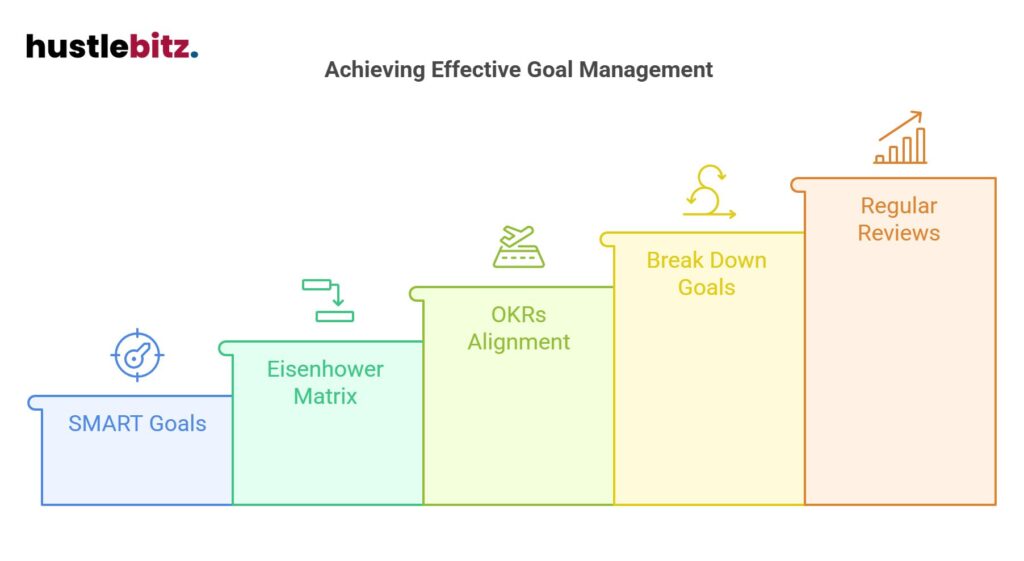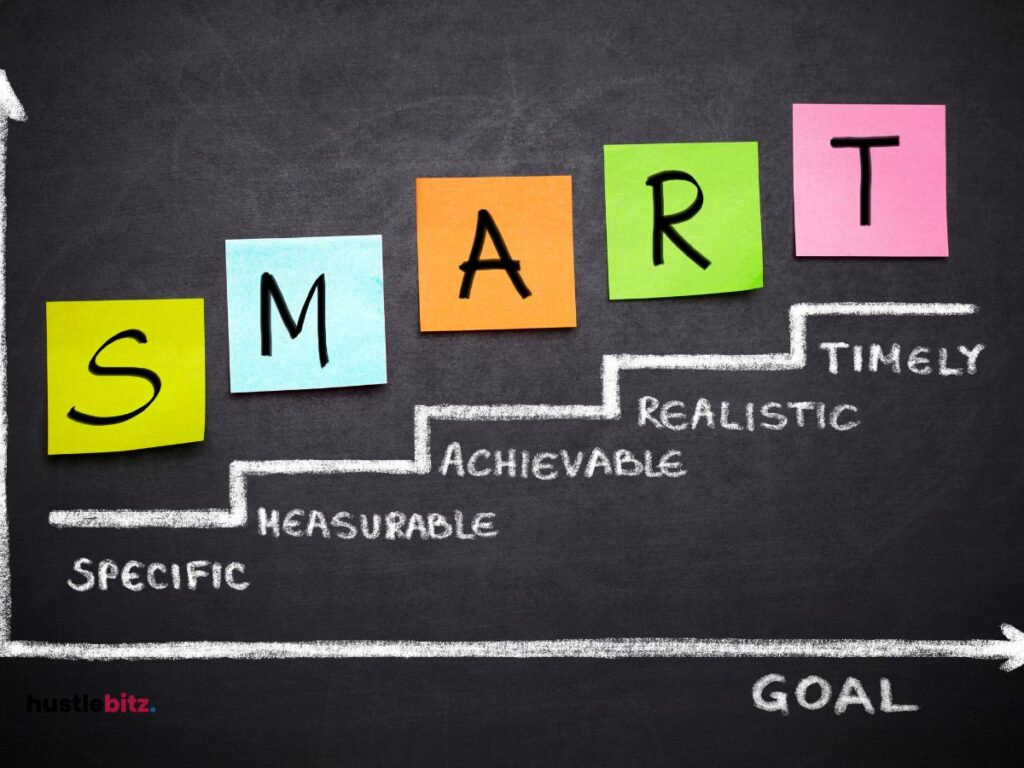Effective goal-setting techniques are vital for enhancing workplace productivity. Utilizing the SMART framework ensures goals are Specific, Measurable, Achievable, Relevant, and Time-bound, providing clarity and direction. Documenting goals enhances accountability and focus, while prioritization methods, such as the Eisenhower Matrix, help in managing tasks effectively. Incorporating Objectives and Key Results (OKRs) aligns individual efforts with organizational objectives, promoting transparency and collaboration. Additionally, breaking larger goals into smaller milestones fosters progress tracking and motivation. Regular reviews and adjustments encourage continuous improvement and adaptability, essential for navigating dynamic work environments. Discover more strategies to elevate productivity in your workplace.
Key Takeaways
- Utilize SMART goals to create specific, measurable, achievable, relevant, and time-bound objectives that enhance focus and motivation.
- Implement the Eisenhower Matrix to prioritize tasks based on urgency and importance for effective time management.
- Incorporate OKRs to align individual goals with organizational objectives, fostering transparency and collaboration among teams.
- Break down big goals into manageable milestones to enhance accountability and maintain motivation throughout the process.
- Regularly review and adjust goals to track progress, reduce stress, and promote a culture of adaptability and continuous improvement.

Importance of Goal Setting in the Workplace

Goal setting in the workplace is crucial, as it provides employees with clear direction and measurable objectives that enhance both individual and organizational performance.
Setting well-defined goals fosters employee motivation by establishing a clarity of purpose, allowing team members to understand their roles in achieving broader company objectives. This alignment not only increases productivity but also promotes a sense of belonging and commitment among team members.
Moreover, effective goal setting utilizes performance metrics to gauge progress, enabling employees to see tangible results from their efforts. Regularly engaging in feedback loops ensures that individuals receive constructive input, which is essential for personal development and continuous improvement.
By integrating accountability systems, organizations can track individual contributions and encourage employees to take ownership of their responsibilities.
Importantly, goal setting can also contribute to a healthy work-life balance by allowing employees to prioritize their responsibilities. When employees set realistic, achievable goals, they can manage their time more effectively, reducing stress and enhancing overall job satisfaction.
Engaging strategies that involve employees in the goal-setting process can further enhance motivation, as individuals feel more invested in the outcomes.
SMART Goals: A Framework for Achieving Workplace Success

A structured approach to goal setting, such as the SMART framework, provides employees with a clear pathway to achieve their objectives and enhance overall productivity in the workplace.
The SMART criteria—Specific, Measurable, Achievable, Relevant, and Time-bound—serve as a powerful tool for creating effective goals that drive performance and success.
By focusing on specific goals, employees can articulate what they want to accomplish, eliminating ambiguity.
Measurable outcomes ensure that progress can be tracked, allowing for adjustments as needed.
Achievable targets motivate individuals by setting realistic expectations that challenge yet remain attainable.
Relevant objectives align with broader organizational goals, fostering a sense of purpose and connection to the company’s mission.
Time-bound deadlines create urgency, promoting efficient time management.
Implementing the SMART framework encourages:
- Performance tracking to monitor progress and identify areas for improvement.
- Team alignment by ensuring that individual goals support collective objectives.
- Continuous feedback, facilitating open communication and adaptation based on performance insights.
- Goal visualization, which aids in maintaining focus and motivation throughout the goal-setting journey.
The Power of Written Goals: Why Documenting Your Goals Matters
Documenting goals significantly enhances accountability and focus, empowering individuals to track their progress and stay committed to their objectives. Written goals provide a clear framework for both personal commitment and team alignment, facilitating enhanced communication among colleagues. By articulating specific targets, individuals gain goal clarity, which serves as a foundation for effective progress tracking.
The act of writing down goals not only solidifies them in the mind but also acts as an accountability measure. This commitment transforms abstract aspirations into tangible objectives, resulting in a motivation boost that drives sustained effort. When team members share written goals, it fosters an environment of collaboration, ensuring everyone is aligned towards a collective long-term vision.
The following table illustrates the benefits of documenting goals:
| Benefit | Description |
| Increased Focus | Clear written goals help prioritize tasks and minimize distractions. |
| Accountability Measures | Documenting goals allows for regular reviews and adjustments. |
| Motivation Boost | Seeing goals in writing reinforces commitment and encourages persistence. |
| Enhanced Communication | Sharing written goals promotes transparency and collaboration within teams. |
Prioritizing Tasks: Using the Eisenhower Matrix for Effective Goal Setting
Effective task prioritization is essential for enhancing productivity, and the Eisenhower Matrix serves as a valuable tool in distinguishing between what is urgent and what is important. This decision-making process allows individuals to categorize their tasks into four quadrants, aiding in effective time management and goal alignment. By utilizing the Eisenhower Matrix, employees can focus on what truly matters, thereby improving their productivity strategies.
The four quadrants of the Eisenhower Matrix are as follows:
- Urgent and Important: Tasks that require immediate attention and contribute to significant outcomes.
- Important but Not Urgent: Tasks that are essential for long-term goals but do not need immediate action.
- Urgent but Not Important: Tasks that demand immediate attention but are not crucial to overall objectives, often suited for delegation.
- Neither Urgent nor Important: Tasks that can be eliminated or postponed, allowing for better work-life balance.
Incorporating OKRs for Enhanced Productivity

Incorporating Objectives and Key Results (OKRs) can significantly enhance workplace productivity by aligning individual goals with broader organizational objectives. OKR implementation fosters team alignment and promotes goal transparency, ensuring that all employees understand how their contributions impact the organization’s success. By establishing measurable outcomes, teams can clearly track their performance and adjust their strategies as needed.
A key component of OKRs is the iterative feedback process, which encourages ongoing communication and collaboration. This approach not only enhances cross-functional collaboration but also boosts employee engagement by involving team members in the goal-setting process. Regular quarterly reviews allow teams to assess their progress and realign their objectives as necessary, ensuring strategic alignment with organizational priorities.
The following table illustrates the elements of effective OKR implementation:
| OKR Element | Description | Benefits |
| Team Alignment | Ensure all team members are working towards shared goals. | Improved collaboration and focus. |
| Performance Tracking | Regularly measure progress against key results. | Enhanced accountability and transparency. |
| Iterative Feedback | Provide continuous feedback to refine objectives. | Increased adaptability and engagement. |
Setting Milestones: Breaking Down Big Goals into Manageable Steps

How can setting milestones transform the approach to achieving large goals by breaking them down into smaller, more manageable steps?
Milestone mapping is a strategic method that enhances goal visualization, allowing teams to see their incremental progress clearly. By segmenting larger objectives into smaller, achievable milestones, organizations can implement effective deadline setting, increasing accountability and focus.
To ensure successful milestone mapping, consider the following strategies:
- Resource Allocation: Identify the resources needed at each milestone to maximize efficiency.
- Accountability Partners: Establish partnerships among team members to motivate and support each other throughout the process.
- Feedback Loops: Create channels for regular feedback to refine strategies and ensure alignment with overall goals.
- Celebration Milestones: Recognize and celebrate the achievement of each milestone, reinforcing motivation strategies that encourage continued progress.
Furthermore, adaptability planning is crucial; it allows teams to pivot based on feedback and evolving circumstances.
This approach not only keeps the momentum going but also fosters a culture of continuous improvement. By focusing on smaller steps, employees are less likely to feel overwhelmed, which can lead to burnout. Instead, they experience a sense of accomplishment with each milestone reached.
This structured strategy transforms overwhelming projects into a series of manageable tasks, ultimately driving productivity and enhancing workplace morale.
The Benefits of Regular Goal Review and Adjustment

Regularly reviewing and adjusting goals is essential for maintaining alignment with evolving organizational priorities and enhancing overall productivity. This process fosters an adaptability mindset, enabling teams to respond effectively to changing circumstances. By engaging in consistent goal review, organizations can implement accountability measures that reinforce commitment and responsibility among team members.
The benefits of this practice are multifaceted, as shown in the table below:
| Benefits | Description |
| Motivation Enhancement | Regular feedback boosts morale and encourages engagement. |
| Stress Reduction | Clear, achievable goals mitigate anxiety and promote focus. |
| Progress Tracking | Monitoring progress allows for timely adjustments and success evaluation. |
Through performance feedback and progress tracking, teams can identify areas for continuous improvement, ensuring that goals remain relevant and attainable. Furthermore, goal adjustments foster team alignment, as members collaboratively assess their paths toward shared objectives.
Incorporating regular goal reviews helps organizations cultivate a culture of transparency and responsiveness, ultimately enhancing workplace productivity. When employees see their contributions valued through structured evaluation, it drives motivation enhancement and reinforces their commitment to team success. In summary, regular goal review and adjustment not only optimize performance but also create a supportive environment that fosters innovation and resilience in the face of challenges.
How to Foster a Goal-Oriented Culture in Your Workplace

Creating a goal-oriented culture in the workplace requires intentional strategies that promote shared objectives and collective accountability among team members. A strong goal-oriented culture not only enhances employee engagement but also fosters team collaboration and drives overall productivity.
To effectively cultivate such an environment, organizations should prioritize the following key elements:
- Leadership Support: Leaders must actively champion goal-setting initiatives, demonstrating their commitment to shared objectives and encouraging open communication.
- Performance Feedback: Regular feedback sessions should be established to discuss progress towards goals, allowing employees to understand their contributions and areas for improvement. This continuous learning approach creates a space for growth.
- Recognition Programs: Implementing recognition programs reinforces positive behaviors and achievements. By acknowledging individual and team successes, organizations enhance motivation and create a sense of belonging.
- Accountability Partnerships: Pairing employees in accountability partnerships can foster a collaborative spirit. These partnerships encourage individuals to support each other’s goals and maintain focus on collective objectives.
Furthermore, effective communication strategies that emphasize diversity inclusion ensure that all voices are heard, promoting a richer exchange of ideas.
By integrating motivational incentives that align with organizational goals, companies can further drive commitment and engagement.
Ultimately, fostering a goal-oriented culture requires a holistic approach that combines leadership support, regular performance feedback, and a focus on continuous learning, ultimately leading to enhanced productivity and workplace satisfaction.
Final Thoughts
Implementing effective goal-setting techniques is essential for driving workplace productivity and achieving organizational success. By utilizing frameworks like SMART goals and OKRs, fostering a goal-oriented culture, and regularly reviewing and adjusting objectives, organizations can create an environment where employees are motivated, aligned, and focused on meaningful outcomes. Additionally, prioritizing tasks, breaking down larger goals into manageable milestones, and documenting objectives can enhance clarity, accountability, and collaboration. By integrating these strategies, businesses can not only improve productivity but also foster a positive work culture that supports continuous growth and adaptation in a dynamic work environment.




